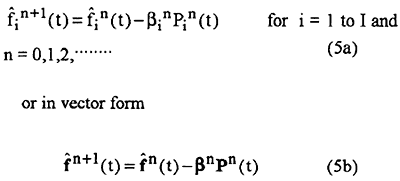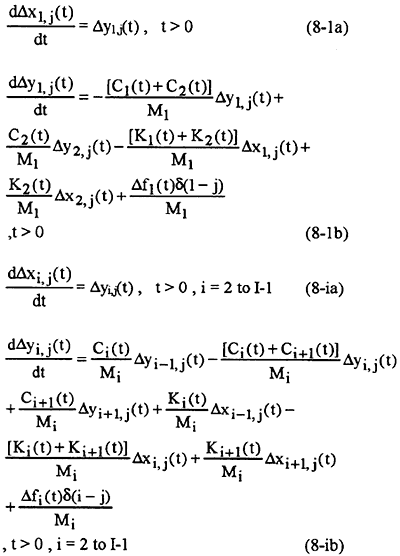The solution of the present inverse vibration problem is to be obtained in such a way that the following functional is minimized:

here, xi(t) are the estimated or computed displacements at time t. These quantities are determined from the solution of the direct problem given previously by using an estimated fi(t) for the exact fi(t). Here the hat " ^ " denotes the estimated quantities.
4. CONJUGATE GRADIENT METHOD FOR MINIMIZATION
The following iterative process based on the conjugate gradient method [9] is now used for the estimation of time dependent external forces fi(t) by minimizing the functional J[f(t)]

where βin are the search step sizes going from n iteration n to iteration n+1, and Pin(t) are the directions of descent (i.e. search directions) given by
Pin=Ji'n(t) + γinPiN-1 (6a)
or in vector form
Pn+1=J'n(t) - γnPn-1(t) (6b)
which are a conjugation of the gradient directions Ji'n(t) at iteration n and the directions of descent
Pin-1(t) at iteration n-1. The conjugate coefficients are determined from

We note that when γin=0 for any n, in equation (7), the directions of descent Pin(t) become the gradient direction, i.e. the "Steepest descent" method is obtained. The convergence of the above iterative procedure in minimizing the functional J is guaranteed in the paper by Lasdon et al. [10].
To perform the iteration s according to equation (5), we need to compute the step sizes βin and the gradient of the functional J'in(t). In order to develop expressions for the determination of these two quantities, a "sensitivity problem" and an "adjoint problem" are constructed as described below.
4-1. SENSITIVITY PROBLEM AND SEARCH STEP SIZE
Since the problem involves I unknown time-dependent external forces f = fi(tn) = {f1(tn),…, f1(t n)} , n = 1 to N. In order to derive the sensitivity problem for each unknown function, we should perturb one unknown external force at a time.
It is assumed that when fi(t) undergoes a variation Δfi(t)gδ(i-j), whereδ(・) is the Dirac-delta function and j = 1 to I, Xi(t) and yi(t) are perturbed by Δxi,j(t) and Δyi,j(t). Then replacing in the direct problem fi(t) by fi(t)+Δfi(t)δ(i-j), xi(t) by xi(t)+ Δxij(t) and yi(t) by yi(t)+ Δyi,j(t), subtracting from the resulting expressions the direct problem and neglecting the second-order terms, we obtained the following I sensitivity problems, (i,e, j = 1 to I), for the sensitivity functions Δxi,j(t) and Δyi,j(t).

BACK CONTENTS NEXT